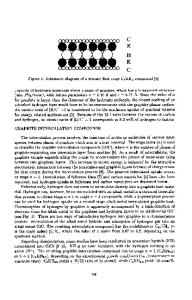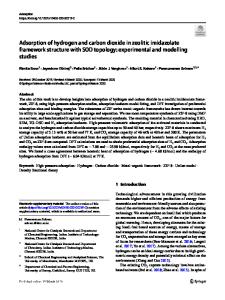Hydrogen Adsorption in Carbon Materials
- PDF / 3,700,188 Bytes
- 6 Pages / 604.8 x 806.4 pts Page_size
- 11 Downloads / 380 Views
ULLETIN/NOVEMBER 1999
achieve the requirements of the DOE Hy drogen Plan. We then refine this basic framework by discussing a few of the re cent detailed calculations and conclude with an outline of the challenges ahead.
Experimental Results A remarkable experimental result for hydrogen storage in an absorbent carbon material was reported by Rodriguez and co-workers.4 Molar fractions [«(H2)/n(C)] of H 2 stored at room temperature in GNFs in the ränge of —1—11 were reported. The H 2 storage was aecomplished at press u r e s well a b o v e a m b i e n t p r e s s u r e (11.35 MPa) for three distinct structural types of GNFs: "tubulär" (90°), "herring bone" (-45°), and "platelet" (0°), where the angle in parentheses indicates the direction of the nanofiber axis relative to the vector normal to the graphene sheets (see Table 1). A graphene sheet is a layer of graphite one atom thick. The struc
tural forms of the GNFs were obtained by varying the sample preparation con ditions, but few details on these condi tions were given in their report,4 making it difficult for other researchers to duplicate their results and to confirm their validity. The GNFs exhibited lengths of 10-100 /im and cross-sectional areas f rom tens to hundreds of Square angstroms. Although this structural Information should be available from transmission electron microscopy (TEM), selectedarea diffraction patterns, and image analysis, these data and images were not presented in their paper.4 It was proposed that the hydrogen was adsorbed in "slit pores" (Figure 1) of width rfp = 3.37 Ä, which is effectively the interplanar spacingbetween graphene sheets in the GNFs. It was found that the platelet and her ringbone forms of GNFs adsorbed 4 - 6 times more H 2 than the tubulär form. The authors proposed that the interpla nar spacing d increases to aecommodate one to several layers of H 2 molecules between successive graphene layers.4 Unfortunately, no in situ structural data, such as the c-axis expansion, on this re markable H 2 storage System are yet avail able. T h i s report s u g g e s t s a d e q u a t e reversibility; for example, adsorption and desorption data on one h e r r i n g b o n e sample exhibited —75% reversibility at room temperature and —0.1 MPa. The desorption was observed to be quite rapid, taking 5-10 min. Dillon etal.' investigated the hydrogenadsorption capacity of bundles of singlewalled carbon n a n o t u b e s (SWNTs)
Table 1: Summary of Reported Gravimetrie Storage of H 2 in Var ious Carbon Materials. Material
Reference
Maxwt%H2
7(K)
P(MPa)
SWNTs (low purity) SWNTs (high-purity) GNFs (tubulär) GNFs (herringbone) GNFs (platelet) Graphite GNFs Li-GNFs Li-Graphite K-GNFs K-Graphite SWNTs (high purity) SWNTs (-50% pure)
1 2 4 4 4 4 5 5 5 5 5 3 15
5-10 -4 11.26 67.55 53.68 4.52 0.4 20.0 14.0 14.0 5.0 8.25 4.2
133 300 298 298 298 298 298-773 -473-673 -473-673
Data Loading...











